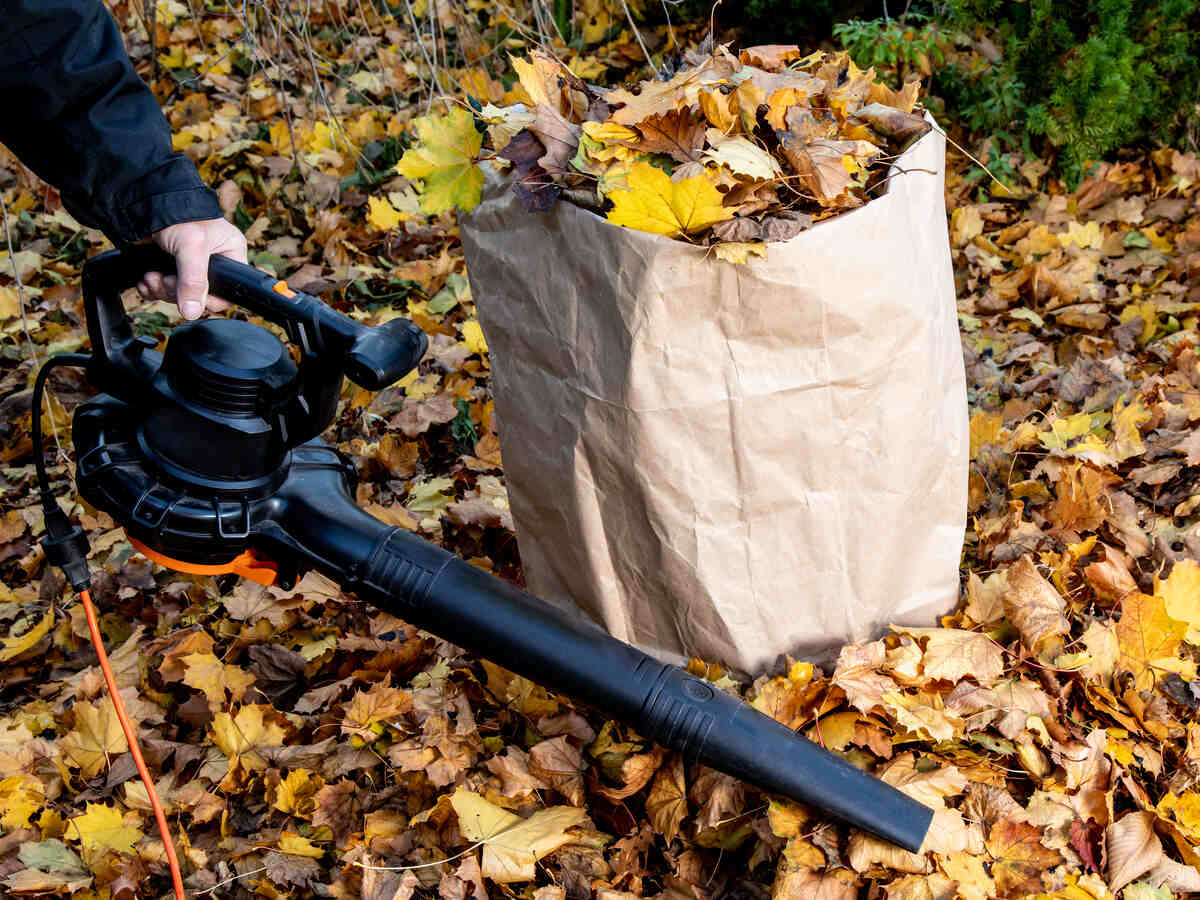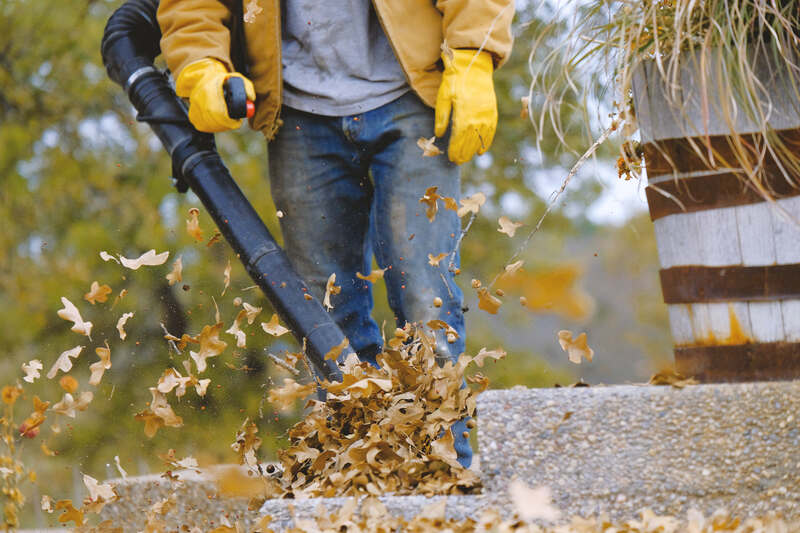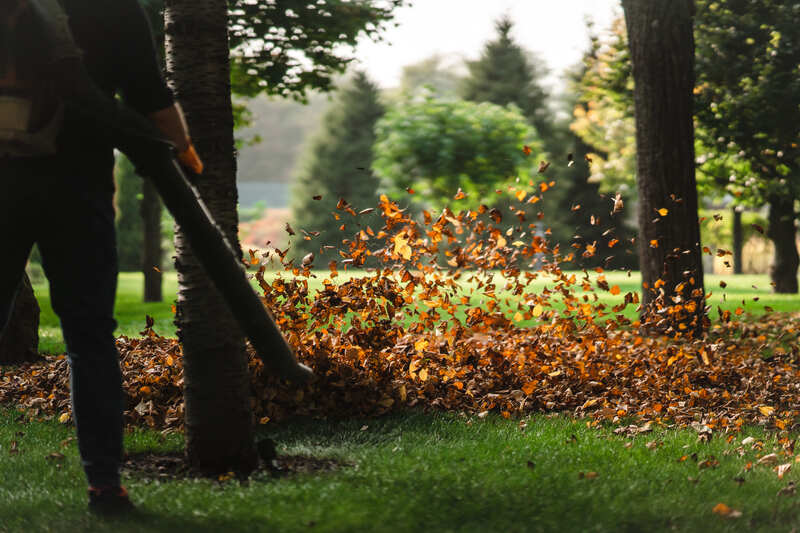
Improper use of leaf blowers can scatter leaves everywhere and even cause physical harm. Here, you’ll learn how to use a leaf blower the right way — from wearing safety gear to cleaning up.
We’ll also discuss how to assess and prepare the area, start up the leaf blower, and use the right techniques to make leaf cleanup a breeze.
| Project Difficulty: Easy Estimated Time to Complete: 30 minutes to several hours — Depends on yard size, number of trees, and volume of leaves Project Cost: Moderate — A leaf blower costs around $90 to $390 (also consider the cost of gas for gas-powered blowers and a new battery for battery-powered blowers), while professional leaf removal costs anywhere from $107 to $435. |
1. Put On Safety Equipment

While a small leaf blower may not look like a health hazard, Romel de Castro, long-time landscaper and lawn care pro, recommends putting on safety equipment to keep you safe and comfortable no matter your leaf blower’s size.
Some “leaf blowers can shoot out air at speeds of over 150 mph,” he says. But less powerful machines also warrant caution.
Here’s a list of the leaf blower safety equipment you need:
- Safety glasses or goggles
- Work gloves
- Mask or dust respirator
- Long sleeves, pants, and closed-toe shoes
- Earplugs or noise-cancelling earmuffs
Pro Tip: Since noise levels above 80 decibels can damage your hearing, de Castro recommends using a cordless electric leaf blower that produces low noise of around 60 to 75 decibels or below. If you’re unsure or your leaf blower’s product specification doesn’t indicate its noise level, always wear earplugs to protect your hearing.
| Buying all the necessary equipment and safety gear can be expensive. To avoid the initial costs, hire a LawnStarter leaf removal pro instead. With a customer rating of 4.3 stars and nearly 12,000 completed jobs last year, our pros make leaf removal effortless for around $158 per service. |
2. Check and Clear the Area
Before leaf blowing, clear the area to help you avoid sending dangerous or heavy items flying. Otherwise, these items can damage your property or, worse, hurt someone.
- Remove any clutter: Store away toys, garden tools, or lawn decorations that can easily become projectiles.
- Pick up large sticks and branches: Your blower won’t be able to move them easily, and they can even damage the nozzle.
- Watch out for rocks and gravel: Pick up any rocks or gravel in the area, as they can fly like bullets if caught in the airflow.
- Move pets indoors: Dogs and cats don’t like the loud sound of leaf blowers. Plus, they can get in your way or get hurt by flying debris.
- Check for wet spots: Wet leaves are heavier and harder to move. Take note of these areas so you can adjust your technique later.
3. Start Your Leaf Blower
You must know how to start a leaf blower, as it depends on the type of leaf blower you’re using. Knowing the right process keeps things simple and helps prevent unnecessary wear and tear.
Gas-powered blowers
- Check the fuel and oil levels.
- Fill the tank with fuel, if needed (use fresh fuel if it’s been weeks since the last use). For the oil, check your owner’s manual if you need to change it annually or more often.
- Examine the nozzle and remove any dirt or blockages.
- Set the choke or primer.
- Pull the cord in firm, quick motions.
- Let the engine warm up for around 30 to 60 seconds before use.
Note: If your gas leaf blower stalls, adjust the choke setting and try again.
Battery-powered blowers
- Fully charge the battery and the spare battery.
- Inspect the nozzle and ensure it’s firmly attached.
- Slide the fully charged battery in until it clicks in place.
- Test the trigger to ensure it’s working properly.
Pro Tip: If you’re using a cordless leaf blower with multiple speeds, start at a low setting and increase the power as needed.
Electric corded blowers
- Ensure the extension cord is long enough to cover the entire area.
- Check the nozzle for clogs and blockages.
- Plug it in and switch it on.
- Mind the cord to avoid tripping on it as you move.
Safety Tip: Don’t use your electric leaf blower if its cord has frays or cracks, as exposed live wires can cause electric shock and fires.
See Related:
— How to Choose a Leaf Blower
4. Use the Right Technique

You can’t just point and blast your leaf blower like you’re one of the Ghostbusters. These leaf blowing tips can help make the job faster, easier, and less tiring:
- Hold the blower properly: Keep the nozzle angled slightly downward and aimed toward the ground.
- Position yourself correctly: Before leaf blowing, check the wind direction so you’ll know where to direct the leaves. “Work with the wind at your back,” says de Castro, “so it won’t undo your hard work.”
- Use proper blowing motion: Move steadily and avoid randomly pointing the blower. You’ll have more control if you do a sweeping, side-to-side motion.
- Work systematically: Start at one edge of the yard and move across in sections.
- Change speed settings when handling different types of debris: Don’t forget to lower the speed setting if you’re removing leaves from flower beds, gravel, or mulch. For stuck or wet leaves, use a higher setting.
Pro Tip: Prevent your leaf blower from overheating by taking breaks every 15 to 20 minutes, especially when using a gas leaf blower.
For more tips on how to use a leaf blower, you can watch this video:
5. Manage Leaf Piles/Collect Leaves
Blowing the fallen leaves into neat piles makes cleanup a lot easier. The key is to work methodically:
- Work in zones: Divide your yard into sections and create small piles in each. This way, the leaf piles will be easier to manage, whether you plan to shred with a mulching mower, bag, or add to a compost pile.
- Use a tarp: Blow the leaves onto a tarp, then drag it to your compost pile or bag them from the tarp and bring to the curb for pickup.
- Choose a good collection spot: It should be near your compost bin or the edge of your property.
- Mind your neighbors: Don’t blow leaves onto the street, sidewalk, or your neighbor’s yard.
See Related:
6. Clean Up
After wielding your leaf blower like a pro, remember to give your equipment and work area a final once-over.
- Final touches: If a few stubborn leaves are clinging to the corners of your flower beds, do a light pass or rake the leaves instead.
- Shut it down properly: Turn off the blower. Remove the battery from a cordless blower or unplug an electric model. For gas models, let the engine cool before putting it away.
- Clean and store equipment: Wipe off dirt and debris, especially around the air vents and nozzle. Store your blower in a dry, secure spot where it won’t get damaged.
FAQ on Using Leaf Blowers
Clogged air filters, dirty spark plugs, weak batteries, or fuel issues can reduce the power of a leaf blower. To restore optimal performance, take your leaf blower to a small engine repair shop or service center for regular cleaning and maintenance.
Yes, you can use your leaf blower to clear light snow, dust from garages, grass clippings, and even dry off equipment or outdoor furniture.
For gas leaf blowers that won’t start, check if you need to refuel or replace the spark plug and/or air filter. For cordless and electric leaf blowers, check the battery charge or cord.
Save Time By Hiring a Leaf Removal Pro
Even with the necessary know-how, using a leaf blower can still be difficult. And cleaning leaves every week can be too much to handle. Luckily, you can always hire a LawnStarter leaf removal pro to clean up the leaves and keep your yard tidy without the hassle. To help manage leaves, also consider hiring a lawn care expert to mow your lawn weekly in the fall.
Read Next:
- How Does a Mulching Mower Work?
- How to Improve Your Lawn With Mulch
- Is it Better to Rake or Mulch Leaves?
Sources:
- “Climate Change at Monmouth.” Monmouth University.
- “Leaf Blower Best Practices – What & Why.” Seattle Department of Construction & Inspections.
- Romel de Castro, landscaper and lawn care pro. Personal interview.
- “Safe Operating Procedures.” The University of Memphis.
Main Image Credit: Leaf blower near a pile of bag of leaves. SockaGPhoto / Adobe Stock Free / License